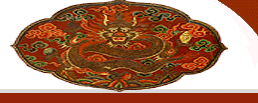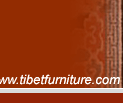|
Symbolism in Tibetan Furniture
|
The decoration of Tibetan furniture is a mixture of Tantric symbolism, bright floral designs, and the use of landscape and narrative painting as a means of conveying spiritual icons for meditation, creating beauty to contrast the native flowerless landscape, and depicting scenes from everyday life.
The eight most important symbols or the 'TASHI DAGEY' symbols to be found on Tibetan furniture are :
- The conch shell.
The conch horn sounds in all directions, as do the teachings of the Buddha. The conch is seen as a vehicle fearlessly proclaiming the truth of the dharma in all directions. It is also seen as an emblem of power and authority and is thought to banish evil
- The lotus
The lotus is an important Buddhist motif. Images of the Buddha and other important persons often are shown seated on a lotus throne. The growth of the lotus, with its roots in mud, growing through water, and emerging as a wonderful plant above the water's surface, is seen as an analogy of the soul's path from the mud of materialism to the air of enlightenment.
- The wheel.
In three parts, the wheel exists as a hub, the center of the world. The 8 spokes, denote the 8 paths to enlightenment. These 8 steps work together, not separately.
- right understanding
- right attitude
- right speech
- right action
- right work
- right effort
- right mindfulness
- right meditation
The rim represents the element of limitation. All are contained within a circle, which is perceived to be perfect and complete, like the teachings of the Buddha.
- The parasol.
The shade cast by the parasol symbolizes wisdom, and the hanging skirt indicates compassion. The parasol is a symbol of protection from the painful heat of suffering and desire. Occasionally, an 8- sided parasol is seen. This element refers to the eightfold path to enlightenment.
- The endless knot.
With no beginning and no end, the endless knot symbolizes the infinite wisdom of the Buddha. It also indicates that all things and actions are linked by cause and effect.
- The pair of golden fish.
Having complete freedom in water, fish represent happiness, fertility, and abundance. On a spiritual level, they represent the abundance of the Buddha's energy , which never diminishes, no matter how much is given away.
- The Victory banner.
An early Buddhist motif meaning the enlightenment of the Buddha and the triumph of knowledge over ignorance, this symbol also is used to recall the Buddha's triumph over his temptress, MIn addition to these 8 primary symbols, there are many others often depicted on Tibetan furniture. A few of the more common ones are listed below, along with a selection of real and mythical animals that are frequently seen.ara.
- The treasure vase
In many cultures, there is the recurring idea of an inexhaustible vessel. In spiritual terms, this represents the Buddha's inexhaustible spirit.
The snow lion is the national emblem of Tibet. A white snow lion, seen with a brown or turquoise mane, represents the earth element, fearlessness, and victory.
The dragon : Unlike its demonic European counterpart, the Tibetan dragon is a creature of great creative power. It has the ability to change size at will, at one time covering the skies, another time being invisible. At the spring equinox it ascends to the sky, where it remains until the autumn equinox, when it descends to a deep pool, living in mud for the winter. It is symbol of heaven and the power of spring. Accompanying the dragon is the elusive flaming pearl. A pair of dragons are often seen fighting over it, chasing it across the sky.
Garuda(Tibetan ' KHYUNG') : A sworn enemy of Nagas and snakes, it represents the fire element and is lord of the skies. He is often seen with a serpent clutched between his talons and beak.
The Tiger : In both Chinese and Tibetan medicine, various parts of the tiger are thought to possess powerful properties. He is the symbol of strength, fearlessness, and military power. The flayed skin is often used as a seat or worn into battle.
In Tibetan Buddhism, the tiger is ridden by many deities, particularly those of a warlike nature. The riding of a tiger symbolizes the fearlessness of the deity.
White Elephant : is a symbol of the strength of the mind. It serves as a symbol of the calm and tranquility possessed by those on the path to enlightenment. Specifically, he embodies the boundless powers of the Buddha.
Deer : Usually seen in pairs, they represent the first teaching given by the Buddha in the great deer park of Sarnath.
They are often seen with the Buddhist emblem of the golden eight-spoke wheel. The deer rest peacefully in attendance on each side of the wheel. The relaxed attitude of the deer conveys the meditative qualities of Buddhism.
Mongoose : As a traditional enemy of Nagas and snakes, (both treasure guardians), the mongoose is usually seen spitting out colored jewels. The symbol may have its origin in the central Asian custom of using a mongoose skin as a money bag.
The Garuda lion : is one of three victorious creatures of harmony. The bonding between Garuda, lord of the skies, and the lion ,lord of the earth symbolizes the unification of heaven and earth in victory.
Kirtimukha or (Tibetan ' Zeebag') : This grotesque symbol is usually seen painted along the top of Thorgam doors. It is the beast of greed and is there to caution against indulgence. It is the result of a demon devouring itself until just the head and hands were left and is usually depicted as a horned face with a bridle in its mouth.
|
|
|




